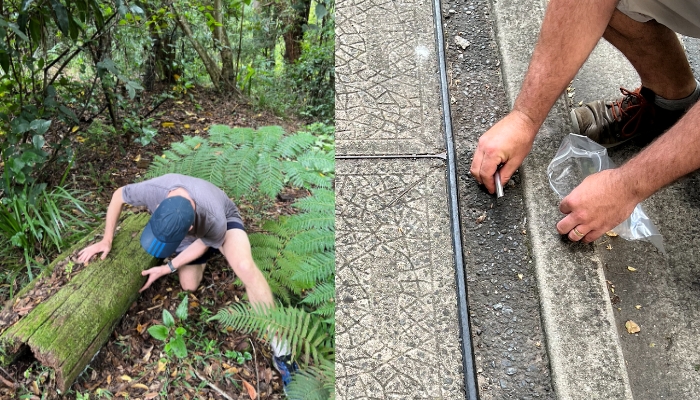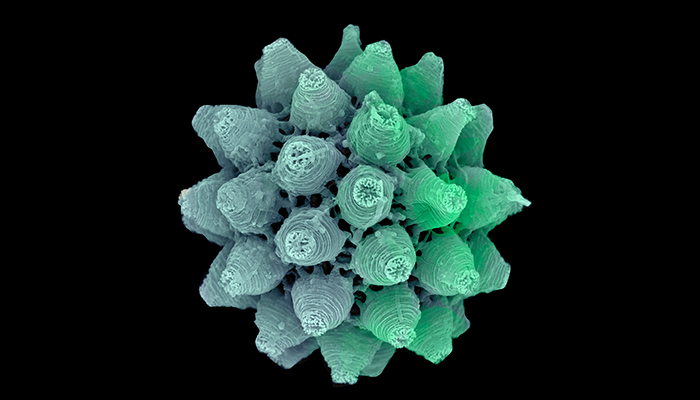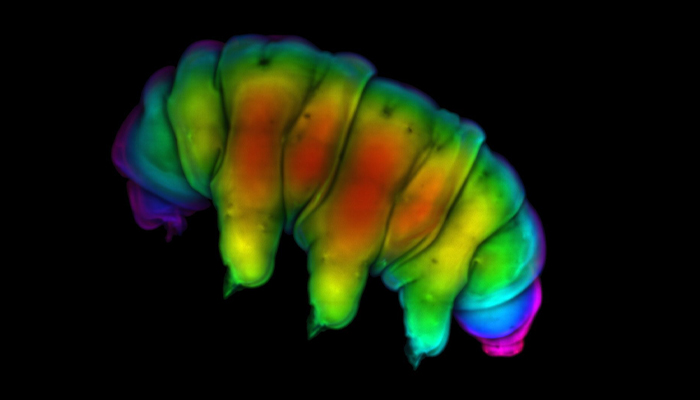When Professor Rob Parton started looking for tardigrades in Brisbane, he combed the luscious green mosses and rainforest areas of The University of Queensland’s riverside St. Lucia campus but had no luck.
He couldn’t understand it. Tardigrades are supposed to live everywhere, but especially in aquatic and mossy environments, hence their nicknames ‘water bear’ and ‘moss piglet’.
“We were finding worm-like creatures that eat tardigrades, but not the tardigrades themselves.”
Just as he was about to give up, Rob’s team member James Rae found some right outside the labs at the Institute for Molecular Bioscience, in a scraping of dry moss on the concrete.
“James brought up this dirty piece of horrible brown moss and put it in water and let it soak – and that area of dry mossy concrete has been our best source of tardigrades ever since.”

Dehydrated tardigrades can survive untouched for over 30 years
Tardigrades are barely visible to the naked eye at approximately 0.5mm in length. Professor Parton pulls out a dish of them and there they are – tiny specks in a petri dish.
“You just add a drop of water to these and five minutes later, you have a wriggling tardigrade whose fascinating features you can view under the microscope.”
Tardigrades are undeniably cute and a sight to behold under the microscope, but why are scientists studying them?
Tardigrades are amazing survivors
Tardigrades can survive the most extreme conditions – dehydration, freezing, lack of oxygen and excess salt.
While there are other species whose eggs or larvae can survive being dehydrated, the tardigrade is the only whole animal who can perform this near-miracle.
NASA is currently studying their survival skills on the International Space Station in the hope that these tiny animals can provide clues on how humans can survive long-duration space travel.

Drying down to 2 per cent
The tardigrades’ key to survival is their ability to enter a state of arrested metabolism, called cryptobiosis, which they achieve by drying down to 2 per cent of their normal water content.
“What is so fascinating is how they go into this dehydrated state - they curl up into a spherical ball with their legs hidden and they can be stored at room temperature until you need to use them,” Professor Parton says.
“You can actually watch them come alive again under the microscope – you add a drop of water and the ‘ball’ starts unfurling and you start to see the legs and the next minute, the tardigrade is crawling around.”
Despite their incredible survival abilities, tardigrades don’t live very long in their animated state – from a few months to a few years, depending on the species.
But with their dehydration ‘superpower’, they can switch states several times a year, resulting in a lifespan that could stretch many decades.

The secret weapon of tardigrades
Professor Parton’s research group specialises in how healthy cells function and what goes wrong in diseased cells.
What gets them and other scientists scintillated is how the tardigrade dries itself up without causing any harm to its cells.
“This dehydration is an incredible stressor on the body, but the tardigrade has evolved a secret weapon - unique proteins that keep its cells safe, reduce stress from lack of oxygen and protect their DNA from damage,” Professor Parton says.
Understanding more about these proteins could have implications for the storage and transport of cells for research, and eggs and sperm in fertility clinics.
Visualising the whole beauty
Professor Parton, who is Deputy Director of UQ’s Centre for Microscopy and Microanalysis, says that as technology improves, so too does microscopy and visualisation of cells.
“The size of the tardigrade is perfect for looking at the whole organism using electron microscopes.
“Within the human body, there are 30 trillion cells and 200 different cell types, making it difficult to visualise how cells work together as a whole.
“Tardigrades are multicellular organisms too, but their small size allows us to visualise their entire body in thousands of virtual slices and see what goes where across the complete animal.”
“We’ve been able to put those images together to create an ‘atlas’ of the tardigrade, which researchers can use as a reference to see how different cells work together.”

‘Just add water’
Every researcher likes an experiment that is easy to source and always ‘ready to go’ – Professor Parton just needs some moss off the pavement outside and a drop of water, and a beautiful tardigrade is standing by, ready to teach us more about cells and survival.

Images taken by Dr Nick Condon from the IMB Microscopy Facility together with Dr Harriet Lo, James Rae and Nick Martel (Parton lab), Nicole Schieber and Rick Webb (UQ's Centre for Microscopy and Microanalysis). Video footage by Dr Tom Hall.
